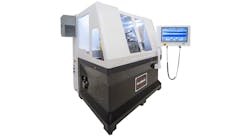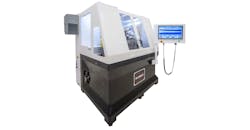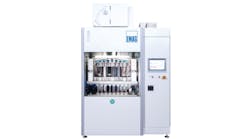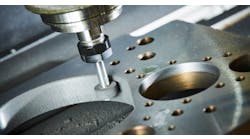New Micro-Grinder for Sub-Micron Accuracy, Repeatability, and Connectivity
Precision-grinding machine developer provider GLEBAR COMPANY announced availability of a new "micro grinder" for medical-device components — called CAM.3. The CAM.3 reportedly was designed "from the ground up" and offers faster speeds and feeds functions; a larger-diameter wheel; increased grinding capability; and connectivity to the Industrial Internet of Things.
Applications like medical guidewires with flats, multiple tapers, hex shapes, and other complex geometries can be easily manufactured on the CAM.3, according to Glebar. And, the new machine also is suited for applications like K wires, bone pins and other orthopedic and sports medicine implants, instruments, and single-use disposable products.
The CAM.3 will accurately grind lengths ranging from 0.005 to 0.375 in. diameter. The 16-in. grinding wheel is mounted on a servo spindle with ABEC 7 spindle bearings, able to reach over 20,944 surface feet. It can be fitted with a six-axis robot, within the enclosure, providing additional axis and automated capabilities. In addition, the work head can be tilted up to 5° to grind sharp corners and true threads. The dual-carriage linear-motor feed system powers the collets, which can spin up to 250 RPS for improved grinding performance.
Built on a 6,500-lb mineral-cast base for vibration dampening, the CAM.3 easily produces parts, repeatedly, to sub-micron accuracy. The positioning of the work wheel, main spindle, and the collets can be programmed using the touchscreen HMI, which features a large 16:9 aspect ratio. IIoT enabled sensors can be built in to monitor temperature, pressure, and vibration of critical mechanical components.
The enclosure includes safety interlocks and the machine is CE-certified for the European market. The base includes embedded air and oil lines. The electrical enclosure includes a built-in AC cooling system.
The CAM.3 comes with MTConnect capability, is OPC UA-compliant, and is ready for Industry 4.0. The CAM.3 controller can be expanded easily to add peripherals such as loaders, inspection gauges, and other automation types.
“Glebar’s technology has been a vital part of the medical device industry for over 68 years,” said John Bannayan, chief technical officer at Glebar. “The expanded features of the CAM.3 will offer designers an incredible set of fabrication capabilities for medical guidewires, orthopedic parts, dental components, and other small precision parts across a number of industries.”
Learn more at www.glebar.com







